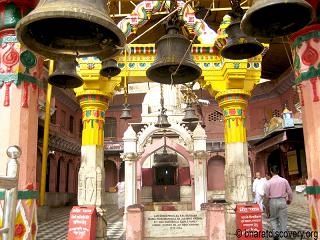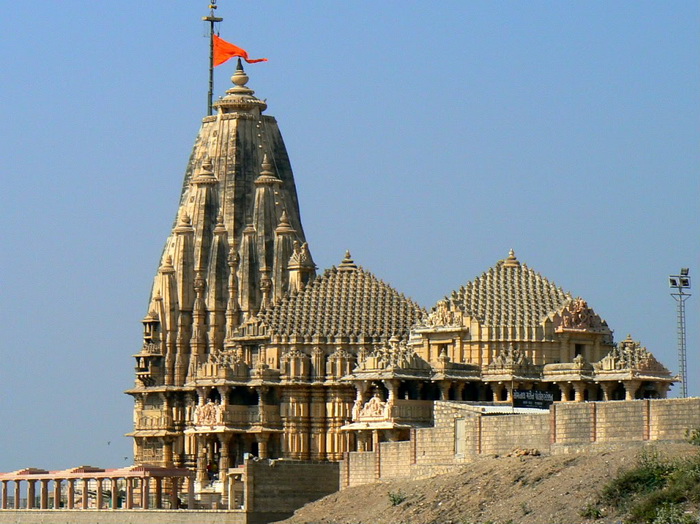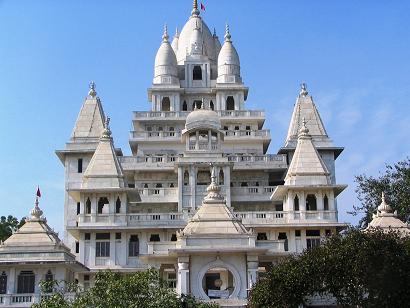|
|
|
Information about
Mathura
|
|
Mathura is an important place of pilgrimage in India as it is the birth place of Lord Krishna. Mathura is one of the most sacred cities of Hinduism and is situated on the western banks of the Yamuna River. The thousands of devotees visit this place throughout the year. It lies at the heart of the Brajbhoomi, a land that is imbued with sanctity, for it was here that the young Krishna was nurtured. The little towns and hamlets in this area are still alive with the tales of his mischievous pranks, his extraordinary exploits and still seem to echo with the sound of his flute. Today, Mathura with its many temples and splendid ghats along the Yamuna river, is an important pilgrimage town. It is also a rapidly growing industrial city. Hindi, English and Brajbhasha are the main languages which are spoken in
Mathura. |
|
|
|
|
History of Mathura |
|
The history of Mathura belongs to 600 BC. Ptolemy mentions the town and it played an important role in the formation of the first to second century Kushan Empire. Kanishka and his successors used it as their capital. The Chinese traveler Hiuen Tsang visited it in 634 AD. At that time it was also important Buddhist centre with over 2,000 followers. Mathura continued to be a centre of power during the enlightened rule of Emperor Ashoka (3rd century BC) and upto the Gupta era (4th century AD). By the time Mahmud of Ghazni came and sacked the city in 1017, Buddhism had virtually disappeared. The Mahmud of Ghazni’s looted Mathura by burning the city, destroying the temples and various numerous jewel encrusted idols were carted off. Sikander Lodi did similar harm to the religious places in 1500 while the Mughal Emperor Aurangzeb used a local revolt in which his governor was killed as an opportunity to destroy all the main temples. The present day Braj-bhoomi was resurrected by the passionate devotion of Sri Chaitanya Mahaprabhu and Mahaprabhu Vallabhacharya in the 16th century. The patronizing rule of Akbar helped seers and devotees redecorate the ancient Braj-bhoomi. The land was largely green, redolent with gardens, groves and lakes in which the Lord frolicked. As the Mughal Empire declined, Jats and Marathas jostled for control. As it lay on the main Dehi-Agra artery it had great strategic value. Its strategic location ensured its location as a centre of trade and a meeting point of the cultures. In the beginning of the 19th century it came under British control. They laid out a cantonment in the south and left a cemetery and the Roman Cathoic Church of the Sacred Heart. Today, Mathura is an important and rapidly growing industrial city. The opening of a big oil refinery on the outskirts of the city in 1975 caused great concern among environmentalists that atmospheric pollution would be carried by prevailing northwesterly winds and irreversibly damage the Taj Mahal. Vallabhacharya, one of the revivers of Braj, first visited Braj in a boat at age 13. On beholding Vishram Ghat, he spontaneously sang a paean in praise. This song, Yamunashtakam in Sanskrit, is still well preserved in the oral tradition of the land, and other songs which have been handed down by greats such as Chaitanya Mahaprabhu, Rupa Goswami, Mirabai, Suradas, Raskhan and Jayadeva. Innumerable poets are born daily in Braj, as devotees are stirred to sing praises of the Lord as they experience him in
Braj-bhoomi. |
|
|
|
|
Festivals of Mathura |
|
The most important festival of Mathura is Janmashtami when the birth of Lord Krishna is celebrated with great pomp and splendour during August. The Holi Gulal Mahotsav is also held here in the month of March and it celebrates Holi in an exuberant way.
|
|
|
|
|
Shopping in Mathura |
|
Idols in metals, granite, sandstone and marble, silver ornaments for deities, temple decorations, fancy fabrics and books are in abundance in Mathura. There are various shops that sell the traditional dresses, designer tulsi jewellery, books on Vrindavan, Krishna and vegetarian cuisine, wooden footwear locally called Paaduka or Chatti and silk and batik paintings and music cassettes.
|
|
|
|
|
Cuisine of Mathura |
|
The Vaishnav cuisine is without meat, onion, garlic or liquor. Iskcon’s restaurant Govinda's offers a wonderful menu for meals, snacks and drinks. The traditional food of Braj-bhoomi is milk and is found in many mouth-watering incarnations in
Vrindavan. Warm kesar milk with the wafting aroma of kesar, an expensive flavouring from Kashmir, is great for a good night’s sleep. Chilled
lassi, a sweet yogurt drink, mattha, a salted digestive drink, chaach buttermilk, reminds of Krishna’s dalliance with the Braj maids for a gift of the above. Butter is the Krishna’s all-time favourite and offered to him for breakfast along with other sweet goodies in all temples. Other sweets include
Peda, Rabari, Khurchan, Malai and milk-cake, all made from cow’s milk.
|
|
|
|
|
Tourist Attractions in Mathura |
|
The main tourist attractions in Mathura are the temples and the ghats on the Yamuna river. The tourist attractions in Mathura are the Jami Masjid, Sati Burj, Kans Qila, Dwarkadheesh Temple and Sri Krishna
Janmasthan. |
|
|
Jami Masjid
The Jami Masjid is situated in the centre of the town of Mathura and was built by Abd-un-Nadi, the governor who was killed. This has four minarets, which were once covered with brightly coloured enamel tiles. The courtyard is raised and above the façade are the ninety nine names of Allah. |
|
|
 |
Ghats
The Yamuna river is a focal point for Hindu pilgrims and a paved street runs the length of it. There are a number of bathing ghats which leads to the water's edge and punctuated by arched gateways and temple spires that extend along the right bank of the river. There are 25 ghats on the Yamuna river and the Vishram ghat is one of the important ghats. The Vishram Ghat is the place where Krishna rested after battle with
Kans. The steps were reconstructed in 1814. The aarti at this ghat is a splendid sight, for hundreds of little oil lamps float out on the river at dusk as offering.
Sati Burj
The Sati Burj is a 17 m. tall four storeyed
square tower of red sandstone with a plastered
dome. It is said to have been built in the
late 16th century to commemorate the death of
the wife of Raja Bhar Mal of Amber, who
committed sati. |
|
|
|
|
Dwarkadheesh Temple
The Dwarkadheesh Temple is situated close to Vishram Ghat and offers an introduction to the heart of Braj. This temple was built in 1814 by the treasurer of Gwalior state. Dwarkadheesh Temple is an architectural jewel, but the barely three-feet-high black deity inside is the show-stealer. The living deity with twinkling eyes and naughty smiles charms visitors. Braj-ki-Holi, the festival of colours is celebrated here in the month of March, Jhulan Utsav in July, Janmashtami in August, and Sharad Purnima in early winter. The Utsav is a recurrent world in Braj lore, meaning to be close to God. The festival is an opportunity to celebrate the innate relationship that God Almighty has with the rest of his creation, of love.
Kans Qila
The Kans Quila (fort) was built by Raja Man Singh of Amber and on the banks of the Yamuna river was rebuilt by Akbar. But, now only the ruins remains of this fort. Maharaja Sawai Jai Singh of Jaipur also built an observatory here at a later date. |
 |
|
|
|
|
Sri Krishna Janmasthan
The splendid temple of Katra Keshav Dev is built over the little prison cell and is believed to be the birthplace of Lord Krishna. A visit to Sri Krishna Janmabhoomi brings one face to face with both facets of Sanatan, ancient Indian theology Sagun and Nirgun. |
|
|
|
|
Excursions
|
 |
Vrindavan
Vrindavan is situated about 12 kms from Mathura, and it is the place where Radha Rani rules. Some of the Krishna temples in Braj often have Radhaji’s crown and jewellery kept near Krishna to symbolize their inseparable identity. Vrindavan is also closely linked to the Lord Krishna's youth and the stories of his playful pranks. It is an important place of pilgrimage like Mathura. Today, it is temple town with ghats along the river and numerous shrines. Kesi Gaht is the most popular ghat on Yamuna river in Vrindavan. It has a grand old frontage. The Yamuna arti is carried out here in the morning and evening. The most important temples in Vrindavan are the Govind Dev temple. This temple was built at an enormous cost of one crore rupees by Raja man Singh of Jaipur in 1590 AD. This temple was under the care of Sri Rupa Goswami,
one |
|
of the 6 disciples that Chitanya Mahaprabhu entrusted with the revival of Vrindavan. This temple is built in the red sandstone in the shape of a Greek cross, and was once a magnificent seven storeyed structure. The other temples in Vrindavan are the Rangaji Temple, the Madan mohan Temple, Banke Bihari temple, Radha Vallabh Temple and Shahji Temple. The ISKCON (International Society for Krishna Consciousness) has also built an ornamental temple at Vrindavan. The Iskcon temple was built in 1975 by Sri Prabhupada, who charmed the west towards Radha Krishna. |
|
|
|
|
Mahaban
Mahaban is situated about 9 km of Mathura on the eastern banks of the Yamuna river. Mahaban means a great forest. There is no forest now, but in 1634 Shah Jahan is recorded as having held a hunt here and killed four tigers. The town was sacked by Mahmud of Ghazni and in 1234 was a rendezvous point for the armies of Shams-ud-din Altamish sent against Kalinjar. The temple of Mathuranathji is worth visiting.
Gokul
Gokul is situated on the banks of the Yamuna river and approached by a long flight of steps (ghat) from the river. Gokul means cow herd. Gokul is situated about 15 km away from Mathura and is associated with very early Hindu legends and is where Vishnu first appeared as Lord Krishna. It is the place where the young Krishna was hidden after his birth and brought up in secrecy by his parents Nand and Yashoda to protect him from Kansa. The members of the Valabhacharya Sect made this place as the headquarters and have built some large temples. The 16th and 17th century temples built here house silver cradles for baby Krishna. Thakurani ghat at Gokul is the seat of Valabhacharya’s followers to this day.
Baldeo
Baldeo is situated about 8 km south east of Mathura, and another place of pilgrimage. This place is associated with Baladeva, Krishna’s elder brother. There is a temple which is dedicated to the Baldeo and the Khirsagar tank (Sea of Milk).
Barsana
Barsana is known as the birthplace of the Sri Radha Rani, Lord Krishna’s consort. The temples built on the elevation of four hillocks are dedicated to the divine couple. These are the only temples in India which Radha is worshipped. The main temple is the Radha Rani temple which is mainly known as the Ladliji Temple. It is a splendid structure in red sandstone and was built by Raja Bir Singh Ju Deo of Orchha in 1675. Barsana is also known for the Lathmar holi.
Nandgaon
Nandgaon was the home of the Lord Krishna's father Nand. The spacious temple dedicated to Nand Rai was built by the Jat ruler Roop singh on the hill. Nandgaon is famous for its Lathmar Holi. Charkula dance is traditionally associated with Braj ki holi. It rules the night with lit diyas, small traditional lamps balanced on the dancing damsels’ heads. They are accompanied by heady Rasiya songs.
Govardhan
Govardhan is greatly venerated as it is considered an incarnation of Krishna himself. It is also famous as the young Krishna lifted the giriraj Hill or govardhan parvat on the tip of the finger to protect the people from an onslaught of rain sent down by the Lord Indra.
|
|
|
|
|
|
How to get here |
|
By Air:
The nearest airport is Kheria, about 62 kms. from Mathura.
By Rail:
Mathura is situated on the main line of the Central and Western Railways and is connected with most important cities around the country like Agra, Delhi, Kolkata, Mumbai, Jaipur, Kanpur and Lucknow.
By Road:
Mathura is located on the NH2 and connected with all major cities like Lucknow, Allahabad, Varanasi, Agra and Delhi.
|
|
|